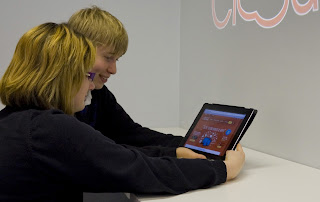This year’s three-day conference focused on the recent changes in education and the escalated need for schools to strengthen their provision of teacher training and information. Web-linked coaching, turbo-charging professional development and plenaries on what head teachers need to know about the high impact (but high-risk) world of mobile learning – these were just a few of the sessions on offer.
Yet, while teacher training had a rightful place in this year’s agenda, it was difficult to ignore the discussions taking place in conference sessions, in social lounges and around the many coffee bars outside the main hall and on the exhibition floor. The ‘flipped classroom’ for me was the real focus of attention and drove many of the conversations I had with delegates.
The interest around flipped learning has not just happened overnight. The evolution of classroom resources and mobile applications has primed our behaviour, but it is only since senior leaders have identified the learning opportunities offered by mobile technologies that we are starting to see real traction.
But what really is a flipped classroom, what isn’t it, how is it achieved and why does it work?
Many of the delegates I spoke to offered only positive comments and success stories. While this doesn’t surprise me it’s important to be aware that some teaching professionals still believe the model is nothing more than a variation on direct instruction, rather than a transformation in teaching and student-centred learning.
During the show, I invited several delegates (whom I knew from past conversations were not proponents of the flipped model) for a coffee and a brief chat about why they had formed these views. So, while I sit on the flipped learning enthusiasts’ bench, in the article below I have taken on board their views to remain as impartial as possible, while offering insight and interpretation on the reasons for and against the flipped classroom.
What it really is
According to flipped classroom pioneers and Bett Show presenters, Aaron Sams and Jonathan Bergmann, in their new publication Flip your classroom: Reach every student in every class every day, they describe the flipped model as a mixture of direct instruction and constructivism. The basis of this approach assigns students with preparation tasks to complete prior to their classroom lesson. Whether assigned for homework or as an on-going scheduled task, students are required to watch recorded lectures or online topic tutorials. Once they attend class the teacher will then set tasks, tests or collaborative exercises to assess each student’s level of understanding.
In the first part of their three-part series of articles, Bergmann tries to relieve the often misguided assumption that flipped learning equals online lectures. This introduces one of the questions that I often get asked; why if flipped learning is transformational does it replace two-way teaching, whereby the teacher can respond to questions and misunderstandings with passive consumption of information?
This is a valid question but focuses on the misconception that flipped learning merely involves independent study, ignoring the interaction that takes place in face-to-face, classroom time in which the teacher can mentor and guide students to higher levels of understanding.
As mentioned, Sams and Bergmann have also identified that flipped learning gives students the ability to watch, replay and question each topic and concept in their own time, and at their own pace. This is significant as not only does it support the different needs and abilities of students, it also helps the learner to fill gaps in their knowledge once in class.
What it’s not
With any new trend that gains rapid interest, suppliers will flock to align their product with it or to adapt their current provision to position it on the back of the surging wave. The Bett Show at times seemed to be a catalyst for this, and it was disconcerting to hear so many vendors pedalling their products as the next big solution to ‘flip your class’.
Don’t get me wrong − there were some software developers that had focused on the individual needs of their target audience throughout their stages of design and development but there were also others that were completely product-oriented. And it quickly became apparent that if I were a newly-appointed head of department or ICT manager it would’ve been easy to walk around and be taken in by the on-stand testimonials and demonstrations, when in reality very few of the resources on offer catered for the full requirements of both the teacher and their learners.
The Khan Academy and TED-Ed are two resources often mentioned in the same breath as flipped classrooms. In conversation with some teaching professionals, this source of free content is often cited as a tick in the box for online resources, providing instructional videos for learners to watch before their lesson. My concern, however, is always that, while it is free, the resources are made for general consumption, and they’re not tailored to the UK’s exam specifications or schemes of work. There is also the argument that while the Khan Academy tutorials provide good, clear instruction, they are two-dimensional. Students listen to a voiceover and watch an onscreen demonstration – identifying how to get a correct answer rather than understanding why this is the correct answer. For learners, the video resources used in the independent study part of flipped learning need to be dynamic, in the same way face-to-face teaching is. The video must engage its audience, with animated or illustrated sequences, on-location sequences, humour or suspense. Tutorials must also correspond to the learner’s curriculum, and be quality assured by real teachers who can validate their accuracy.
Why it works
In many of the discussions I have had, both directly with teachers and in online forums, teaching professionals often highlight two significant attributes of the flipped classroom. The first is directed at students and the way in which the flipped classroom truly supports personalised learning. For most teachers, video resources are made available on multiple devices, offering the advantages of mobile technology, and helping students to learn at their own pace, at a time that’s convenient to them and on a device that’s most accessible. Teachers often agree that this caters for differing ability streams without impacting on the support offered to each student in class. Proponents are also quick to identify the ease at which students who miss a class can catch up on content, or the way that students can revise and refresh their understanding in their own time.
So what does all this mean?
Whether you’re a flipped classroom enthusiast or still sitting on the fence regarding its advantages, the reason educationalists are so interested in this model is not just because it offers an effective way of introducing technology into the classroom. It is also because of its potential to force teachers to rethink their teaching methods. The flipped classroom concept is inspiring teachers throughout the UK to challenge their current teaching style and methods of delivery.
Video and virtual learning resources are not new but the way in which they can be used to accelerate learning, free-up teachers’ time in lessons and personalise learning for students, is new. Flipped classroom modelling helps teachers focus on learning, reflect on and question best practices and invites new and innovative ways to engage learners with the use of digital resources.



